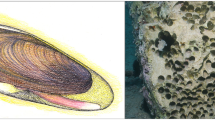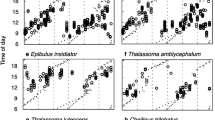Abstract
A very distinct semilunar spawning cycle was found in a population of the damselfish Dascyllus aruanus on the coral reefs of Sesoko Island, Okinawa. Spawning occurred from June to September, only in the early morning, during a period of 2–4 days immediately before or around the time of the new and full moon. Males cared for the eggs deposited on the substrate for 2.5 days until hatching. Hatching occurred just after sunset, i.e., at the high tide of spring tide; the strong ebb current then would rapidly disperse the newly hatched larvae offshore. Females tended to synchronize spawning in a male's nest, also because multiple clutches in a nest would be more likely to survive until hatching. Thus, the distinct semilunar spawning cycle may favor females in reducing mortality of both eggs and larvae.
Similar content being viewed by others
Author information
Authors and Affiliations
Additional information
Received: July 9, 1999 / Accepted: January 29, 2000
About this article
Cite this article
Mizushima, N., Nakashima, Y. & Kuwamura, T. Semilunar spawning cycle of the humbug damselfish Dascyllus aruanus . J Ethol 18, 105–108 (2000). https://doi.org/10.1007/s101640070008
Issue Date:
DOI: https://doi.org/10.1007/s101640070008




